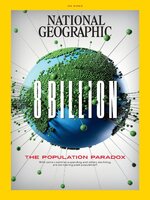Amazing discoveries and experiences await you in every issue of National Geographic magazine. The latest news in science, exploration, and culture will open your eyes to the world’s many wonders.
FROM THE EDITOR
STILL STEPPING OUT • In Sun City, Arizona, retirement community residents march to the beat of their own vitality.
THE BACKSTORY • AS A PHOTOGRAPHER DOCUMENTS A SOCIETY OF OLDER ADULTS, SHE GETS A LESSON IN LIVING.
Patriarchy Is Not Destiny • MALE-DOMINANT SOCIETIES MAY BE THE NORM TODAY—BUT BIOLOGY DOESN’T DICTATE THAT, AND HISTORY SHOWS US OTHER OPTIONS.
When Matriliny Thrived in India
Power, Balanced
DISPATCHES FROM THE FRONT LINES OF SCIENCE AND INNOVATION
PICTURE THE DECEASED • EGYPTIANS BURIED PORTRAITS — SOME POSSIBLY ENHANCED—ALONG WITH MUMMIFIED REMAINS.
This bird has a built-in umbrella
INEZA UMUHOZA GRACE • She inspires young people to take action on climate change.
LIVING LARGE
THE AGE OF ANIMALS • With fewer predators, bigger animals tend to live longer. Smaller creatures, typically prey, must grow and breed quickly to pass on their genes during shorter life spans. Animal outliers to these norms often live in niche habitats and have evolved to ward off both external and biological perils.
BEHIND THE MASK
Memory Meets Change • AS TWO PHOTOGRAPHERS COVER EARTH’S EIGHT BILLION, THEY GATHER IMAGES AND INSIGHTS FROM LANDS THEY KNOW WELL.
8 BILLION THE HUMAN POPULATION EXPLOSION
THE DEMOGRAPHIC DIVIDEND • When fertility rates drop and workers make up more than two-thirds of the population, a country with a functioning economy has a rare opportunity to invest in itself. China already reaped this dividend; Nigeria’s lies in the near future. But if fertility rates drop too far, below 2.1 births per woman, the number of older adults can overwhelm the system
POPULATION GROWTH TAPS THE BRAKES • People in Nigeria and China—and in fact in every country in the world—are living longer thanks in part to improved health care and rising standards of living. But falling fertility rates are acting as a global counterweight to the trend toward longer lives.
A LESS FERTILE WORLD • Improving women’s access to education, employment, and birth control has helped cut the global fertility rate in half since 1950. Sub-Saharan Africa, which has not evenly experienced these social changes and where large families are the norm, is the world’s last region to sustain a high fertility rate. As a result, many African populations will continue to grow while populations will decline elsewhere.
NIGERIA WHERE POPULATION IS GROWING • BY 2050, NIGERIA IS EXPECTED TO SQUEEZE 377 MILLION PEOPLE INTO A COUNTRY LESS THAN ONE-TENTH THE SIZE OF THE UNITED STATES. WHAT WILL LIFE LOOK LIKE FOR A CHILD GROWING UP IN AFRICA’S MOST POPULOUS COUNTRY?
THE RISE OF AFRICA • Two-thirds of global population growth between now and 2050 will come from sub-Saharan Africa. Nigeria is forecast to become the world’s third most populous country by then, with a median age under 23.
CHINA WHERE POPULATION IS SHRINKING • CHINA HAS BEEN THE MOST POPULOUS COUNTRY FOR CENTURIES. BUT INDIA WILL SURGE TO THE TOP THIS YEAR AS CHINA’S POPULATION BEGINS A PERILOUS DECLINE. WHAT HAPPENS WHEN A NATION PASSES THE TIPPING POINT?
SEASONS OUT OF SYNC • WHAT BIRDS AND BEES ARE TELING SCIENTISTS ABOUT NATURE’S SHIFTING CLOCK-AND WHAT THAT MEANS FOR US
CHANGE OF PACE • Across much of the United States rising average temperatures are pushing spring to speed up its arrival. Plants and pollinators found at high elevations in the western U.S. are especially affected. To better understand how species are interacting and responding to these changes, scientists are tracking the timing of biological events—a field...

 Dec 01 2024
Dec 01 2024
 Nov 01 2024
Nov 01 2024
 Oct 01 2024
Oct 01 2024
 Sep 01 2024
Sep 01 2024
 Aug 01 2024
Aug 01 2024
 Jul 01 2024
Jul 01 2024
 Jun 01 2024
Jun 01 2024
 May 01 2024
May 01 2024
 Apr 01 2024
Apr 01 2024
 Mar 01 2024
Mar 01 2024
 Feb 01 2024
Feb 01 2024
 Jan 01 2024
Jan 01 2024
 Dec 01 2023
Dec 01 2023
 Nov 01 2023
Nov 01 2023
 Oct 01 2023
Oct 01 2023
 Sep 01 2023
Sep 01 2023
 Aug 01 2023
Aug 01 2023
 Jul 01 2023
Jul 01 2023
 Jun 01 2023
Jun 01 2023
 May 01 2023
May 01 2023
 Apr 01 2023
Apr 01 2023
 Mar 01 2023
Mar 01 2023
 Feb 01 2023
Feb 01 2023
 Jan 01 2023
Jan 01 2023
